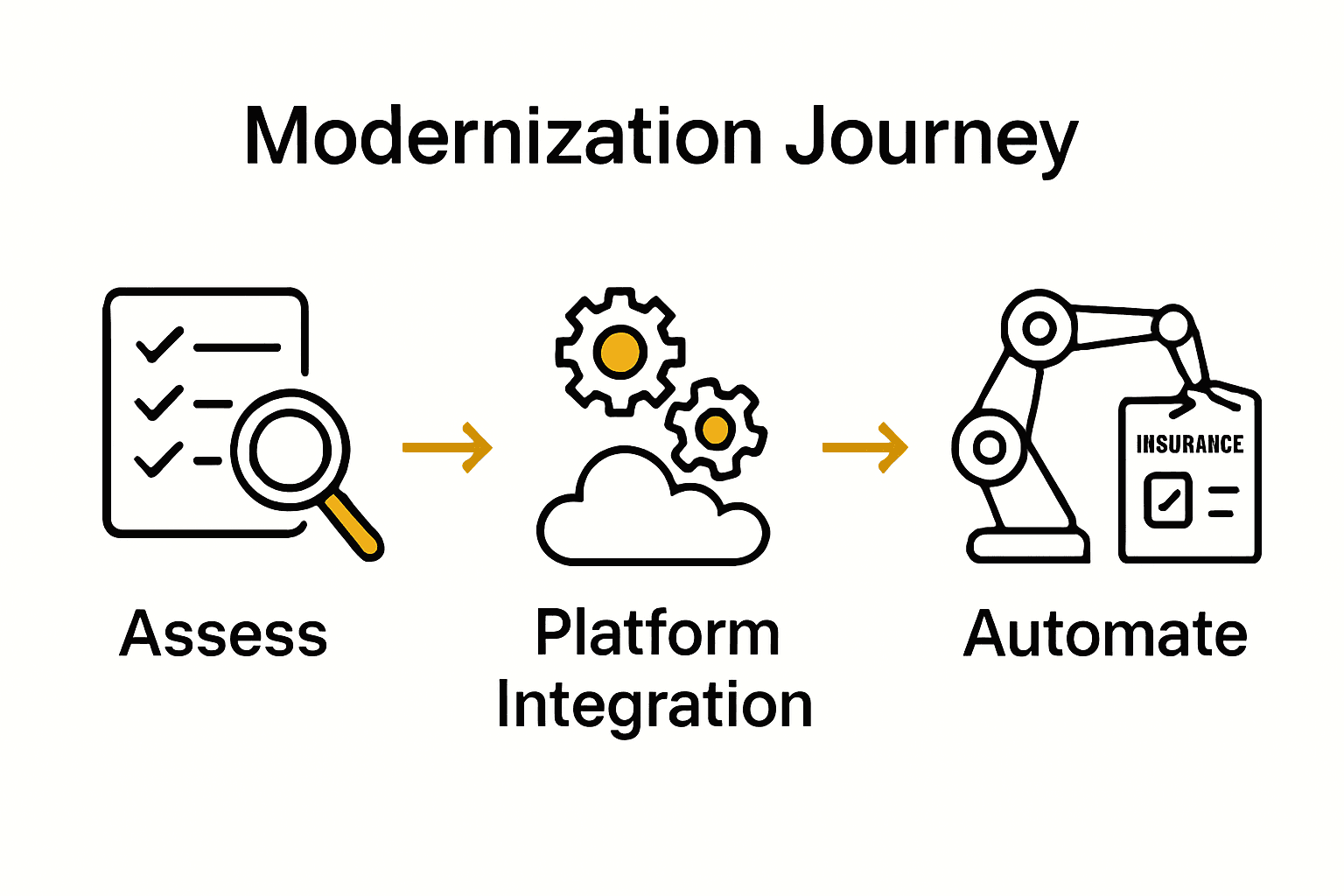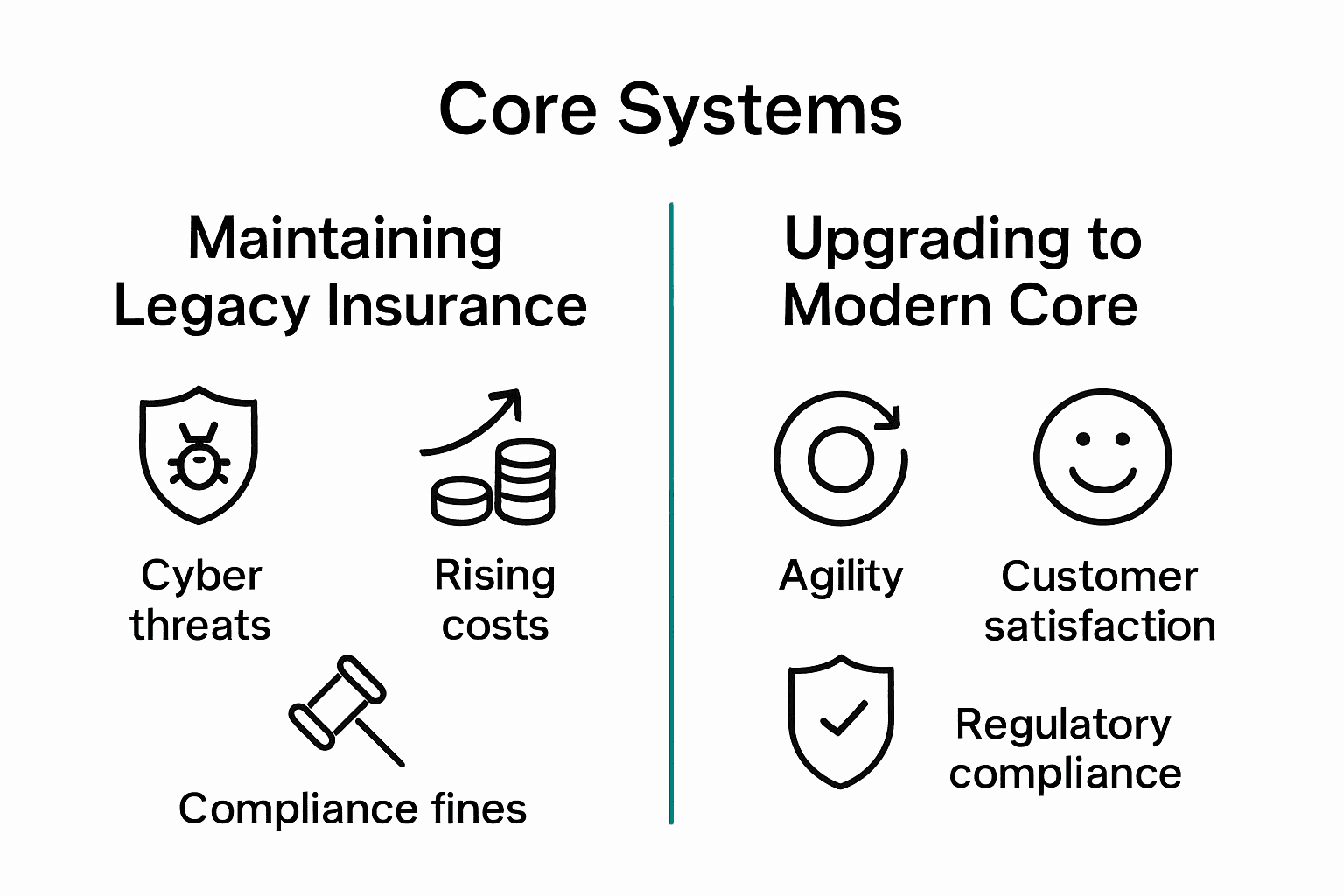Many insurance providers now cite scalability as their top technology challenge. With growing data volumes and complex customer needs, insurers cannot afford slow platforms or poor experiences. Understanding how scalable architecture supports business growth can help organizations stay competitive and responsive, no matter how large or demanding their operations become.
Table of Contents
- Defining Insurance Platform Scalability
- Core Scalability Features And Architecture
- Types Of Scalability In Insurance Platforms
- Integration, Cloud, And Regulatory Considerations
- Risks, Challenges, And Best Practices
Key Takeaways
| Point | Details |
|---|---|
| Insurance platform scalability | Scalability is crucial for insurance platforms, allowing them to grow and handle increased workloads without sacrificing performance. |
| Microservices architecture | This framework enhances scalability through modularity and independent deployability, enabling rapid adaptation to changing market demands. |
| Types of scalability | Insurance platforms can implement vertical, horizontal, diagonal, and functional scalability to meet various operational and technological needs. |
| Risk management | Effective scalability requires proactive mitigation strategies for technological, operational, compliance, and financial risks to ensure ongoing performance and regulatory adherence. |
Defining Insurance Platform Scalability
Insurance platform scalability represents the technological capability of an insurance system to dynamically expand computational resources, manage increasing workloads, and accommodate business growth without compromising performance or user experience. According to research from ijsrm, scalability becomes particularly critical when managing complex customer data across multinational insurance operations.
At its core, platform scalability involves three fundamental dimensions: vertical scaling, horizontal scaling, and architectural flexibility. Vertical scaling allows systems to increase capacity by adding more computational power to existing infrastructure, while horizontal scaling enables distributed processing across multiple servers or cloud environments. Journals research specifically highlights how microservices architectures have become instrumental in achieving enhanced scalability, enabling insurance platforms to adapt rapidly to changing operational demands.
Successful insurance platform scalability isn’t just about technical infrastructure—it requires strategic alignment between technological capabilities and business objectives. Key considerations include:
- Ability to handle sudden traffic spikes without performance degradation
- Support for geographically distributed operations
- Seamless integration with emerging technologies
- Cost-effective resource allocation
- Maintaining robust security protocols during expansion
Modern insurance platforms must design scalability as a core architectural principle, not an afterthought. This approach ensures technological resilience, operational efficiency, and the agility to respond quickly to market transformations.
Core Scalability Features and Architecture
Microservices architecture has emerged as the foundational framework for modern insurance platform scalability, enabling unprecedented flexibility and technological resilience. According to research from eajournals, this architectural approach represents a transformative strategy for digital insurance platforms, fundamentally reshaping how computational resources are designed, deployed, and managed.
Arxiv research highlights that microservices architecture achieves scalability through key features like modularity and independent deployability. This means each service component can be developed, scaled, and updated autonomously without disrupting the entire system. The core scalability features include:
- Containerization for lightweight, portable service deployment
- Event-driven communication protocols
- Stateless service design
- Dynamic resource allocation
- Automated scaling mechanisms
- Decentralized data management
The architectural approach goes beyond mere technological implementation. It represents a strategic framework that allows insurance platforms to adapt rapidly to market changes, integrate emerging technologies, and maintain optimal performance under varying computational demands. By breaking down monolithic systems into smaller, interconnected services, insurers can achieve unprecedented operational agility and technological resilience.

Types of Scalability in Insurance Platforms
Scalability in insurance platforms manifests through multiple strategic dimensions, each addressing different technological and operational requirements. Arxiv research reveals that transitioning from monolithic to microservices architectures enables insurers to achieve more sophisticated and nuanced scalability models that go beyond traditional computational expansion.
Primarily, insurance platforms can implement four distinct scalability types: vertical, horizontal, diagonal, and functional. According to Arxiv research analyzing big data platform architectures, these scalability approaches provide comprehensive strategies for managing technological complexity and operational demands:
- Vertical Scalability: Adding computational resources to existing infrastructure
- Horizontal Scalability: Distributing workloads across multiple servers or cloud environments
- Diagonal Scalability: Combining vertical and horizontal scaling techniques
- Functional Scalability: Adapting system architecture to support new business processes and technological integrations
Each scalability type addresses unique challenges in insurance technology ecosystems. Functional scalability, for instance, allows platforms to rapidly integrate emerging technologies like artificial intelligence and machine learning without completely redesigning core system architecture. By understanding and strategically implementing these scalability models, insurance organizations can build resilient, adaptive technological infrastructures that respond dynamically to changing market conditions and operational requirements.

Integration, Cloud, and Regulatory Considerations
Cloud migration and technological integration represent critical strategic imperatives for modern insurance platforms. MDPI research highlights the transformative potential of digital platform economies, emphasizing that successful integration goes far beyond mere technological implementation and requires comprehensive strategic alignment.
According to BCG research, insurers must navigate three fundamental considerations when approaching integration and cloud adoption:
- Technological Compatibility: Ensuring seamless connections between legacy systems and modern cloud infrastructure
- Regulatory Compliance: Maintaining stringent data protection and privacy standards
- Operational Resilience: Developing robust architectural frameworks that support continuous innovation
The intricate landscape of integration demands a nuanced approach that balances technological innovation with regulatory requirements. Successful insurance platforms must design architectures that not only enable rapid technological adaptation but also maintain rigorous compliance protocols. This means creating flexible, secure ecosystems that can rapidly respond to changing market dynamics while protecting sensitive customer data and meeting increasingly complex regulatory mandates. By prioritizing strategic integration and cloud-native design, insurance organizations can transform potential technological challenges into competitive advantages.
Risks, Challenges, and Best Practices
Insurance platform scalability introduces complex risk management challenges that require strategic foresight and proactive mitigation strategies. Cambridge research highlights the critical importance of understanding the nuanced risks inherent in technological platform expansion, emphasizing that scalability is not merely a technical endeavor but a comprehensive risk management approach.
According to Arxiv research, insurance platforms must address several key risk categories:
- Technological Risks: Potential system failures, security vulnerabilities, and integration challenges
- Operational Risks: Performance degradation, unexpected downtime, and resource allocation inefficiencies
- Compliance Risks: Regulatory violations, data protection breaches, and privacy concerns
- Financial Risks: Cost overruns, inefficient resource utilization, and potential revenue loss
Best practices for mitigating these risks involve developing a comprehensive, multi-layered approach that prioritizes continuous monitoring, adaptive infrastructure, and robust risk assessment frameworks. Successful insurance platforms must create flexible architectural models that can rapidly identify, isolate, and resolve potential vulnerabilities while maintaining optimal performance and regulatory compliance. This requires a dynamic risk management strategy that views technological scalability not as a one-time implementation, but as an ongoing, iterative process of technological optimization and strategic refinement.
Unlock Seamless Insurance Platform Scalability with IBA
Scaling an insurance platform effectively is a complex challenge that requires more than just adding resources. The article highlights critical pain points such as managing sudden traffic spikes, integrating emerging technologies, and maintaining regulatory compliance—all while ensuring performance and security remain uncompromised. Concepts like microservices architecture, cloud migration, and functional scalability are essential to building a resilient system that can grow with your business needs.
At Insurance Business Applications (IBA), we understand these challenges and deliver solutions that address them directly. With our cloud-native IBSuite platform, you gain access to a secure, API-first system designed for efficient vertical and horizontal scaling, seamless integration, and continuous regulatory compliance. IBSuite empowers P&C insurers to accelerate digital transformation by streamlining operations from sales through claims to billing, while enabling rapid product innovation and enhancing customer engagement.
Ready to transform your scalability challenges into strategic advantages? Explore how IBSuite’s flexible architecture and automated scaling can future-proof your insurance business. Book a personalized demo today at Book a Demo and discover how IBA supports your full insurance value chain with trusted cloud technology. Don’t wait—take the first step toward effortless growth and operational agility now.
Frequently Asked Questions
What is insurance platform scalability?
Insurance platform scalability refers to the ability of an insurance system to dynamically expand its computational resources and manage increasing workloads, ensuring performance and user experience are maintained as the business grows.
What are the key types of scalability in insurance platforms?
The four distinct types of scalability in insurance platforms are vertical, horizontal, diagonal, and functional scalability. Each type addresses unique challenges related to resource allocation and system architecture adaptability.
How does microservices architecture improve insurance platform scalability?
Microservices architecture enhances scalability by enabling modular and independent deployability, allowing each service component to be developed and updated without disrupting the entire system, thus providing greater operational agility and technological resilience.
What are the primary considerations for integrating cloud technology into insurance platforms?
The main considerations for integrating cloud technology into insurance platforms include ensuring technological compatibility with legacy systems, maintaining regulatory compliance regarding data protection, and developing operational resilience to support continuous innovation.
Recommended
- Insurance Platform Flexibility Explained: Key Benefits – Digital Insurance Platform | IBSuite Insurance Software | Modern Insurance System
- Modern Insurance Platforms: What to look for – Digital Insurance Platform | IBSuite Insurance Software | Modern Insurance System
- Insurance Platform Architecture Explained: Complete Guide – Digital Insurance Platform | IBSuite Insurance Software | Modern Insurance System
- Solving Product Development Challenges – Digital Insurance Platform | IBSuite Insurance Software | Modern Insurance System

















 The next step involves monitoring these automated processes and continuously refining their performance to drive ongoing operational excellence.
The next step involves monitoring these automated processes and continuously refining their performance to drive ongoing operational excellence.










